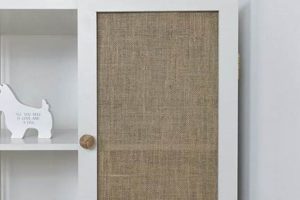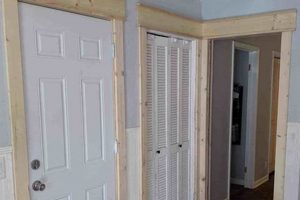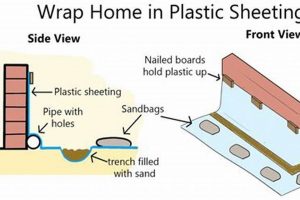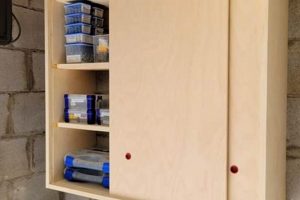The construction of cabinet fronts featuring a recessed panel framed by four flat pieces of wood, commonly undertaken as a home improvement project, offers a blend of simplicity and elegance. These components, often associated with a minimalist aesthetic, are readily adaptable to diverse interior design schemes. For instance, one might choose to construct these features from maple and finish them with a clear coat to showcase the natural wood grain, achieving a contemporary look in a kitchen remodel.
Engaging in this type of fabrication presents several advantages. It provides a cost-effective alternative to purchasing pre-made options, allowing for customization of dimensions and materials. Historically, this design gained prominence due to its functional design and ease of manufacture, making it a popular choice across various economic strata. The clean lines contribute to a timeless appeal, ensuring longevity in style and utility.
The following sections will delve into the essential steps for building these cabinet elements. From selecting appropriate wood species and tools to mastering joinery techniques and achieving a flawless finish, a practical guide will be provided. Furthermore, a consideration of various design modifications and hardware choices that further enhance the project will also be reviewed.
Construction Tips for Shaker-Style Cabinet Facades
Achieving professional-quality results in cabinet door construction necessitates meticulous planning and precise execution. The following guidelines are designed to optimize the fabrication process and ensure a durable, aesthetically pleasing outcome.
Tip 1: Material Selection is Paramount: Opt for hardwoods such as maple, poplar, or birch for superior stability and paint adhesion. Softwoods, while less expensive, are prone to denting and may not provide a smooth surface for finishing. Ensuring consistent grain patterns within a single cabinet set enhances visual harmony.
Tip 2: Prioritize Accurate Measurements: Precise measurements are critical for achieving uniform reveals and a professional appearance. Develop a detailed cut list and verify all dimensions before commencing any cutting operations. Consider the thickness of the saw blade (kerf) in calculations to prevent inaccuracies.
Tip 3: Master the Joinery: Employ robust joinery techniques, such as mortise-and-tenon or cope-and-stick joints, to ensure structural integrity. These joints provide a greater surface area for adhesive bonding and mechanical fastening compared to simple butt joints. Precise alignment is key to avoiding gaps and misalignments.
Tip 4: Implement Proper Clamping Procedures: During assembly, utilize an adequate number of clamps to apply uniform pressure across all joints. Insufficient clamping can result in weak bonds and warped frames. Allow sufficient drying time for the adhesive according to the manufacturer’s recommendations.
Tip 5: Sanding is Essential for a Flawless Finish: Thorough sanding is necessary to achieve a smooth, even surface prior to finishing. Progress through a sequence of grits, starting with a coarser grit to remove imperfections and gradually transitioning to finer grits for polishing. Dust removal is crucial between sanding stages.
Tip 6: Apply Finish Evenly: Whether staining or painting, apply the finish in thin, even coats to avoid runs and drips. Multiple thin coats are preferable to a single thick coat. Consider using a spray gun for a professional-looking finish. Always allow each coat to dry completely before applying the next.
Tip 7: Select Appropriate Hardware: Choose hardware that complements the design and functionality of the cabinets. Consider the size, style, and finish of the knobs or pulls. Ensure the hardware is properly aligned and securely attached.
Adhering to these guidelines will significantly improve the quality and longevity of the fabricated cabinet elements. The investment in proper techniques and materials will yield aesthetically pleasing and functionally sound results.
With these tips in mind, the following discussion will transition into advanced techniques and potential design variations for enhancing the overall project.
1. Material Selection
Material selection constitutes a foundational aspect in the construction of shaker-style cabinet facades. The choice of material dictates not only the aesthetic character of the finished product but also significantly influences its durability, workability, and ultimately, its long-term value. A thorough understanding of material properties is therefore essential for a successful fabrication.
- Hardwood Species and Stability
Hardwoods such as maple, cherry, and oak offer superior dimensional stability compared to softwoods like pine. Dimensional stability refers to a material’s ability to resist warping, twisting, and cracking in response to changes in humidity and temperature. Cabinet doors constructed from unstable materials are prone to misalignment and structural failure over time. For example, a pine door subjected to significant moisture fluctuations may exhibit noticeable warping within a few seasons, compromising its functionality and visual appeal.
- Paint-Grade vs. Stain-Grade Materials
The intended finishing method significantly impacts material selection. Paint-grade materials, such as poplar or maple, possess a smooth, uniform surface that accepts paint readily. Stain-grade materials, like cherry or walnut, exhibit attractive grain patterns that are enhanced by staining. Attempting to stain a paint-grade material may result in an uneven and blotchy appearance due to variations in density. Conversely, painting a high-end stain-grade material may obscure its inherent beauty and represent an unnecessary expense.
- Sheet Goods for Panel Insets
For the recessed panel component, alternatives to solid wood exist. Plywood or Medium Density Fiberboard (MDF) are often employed. Plywood offers good stability but may exhibit visible grain. MDF presents an exceptionally smooth surface ideal for painting and offers consistent density, though it is more susceptible to moisture damage than plywood. The panel material’s thickness must be considered when designing the overall door construction. For instance, a thinner MDF panel may require a deeper groove in the frame to ensure secure retention.
- Cost-Benefit Analysis
Material costs can vary widely, impacting the overall project budget. While premium hardwoods offer superior performance and aesthetics, more economical alternatives may be suitable for certain applications. A careful cost-benefit analysis should be performed, considering the long-term durability and maintenance requirements of different materials. For example, using a less expensive material like poplar and applying a high-quality, durable paint finish may provide a cost-effective solution without sacrificing longevity. The location of the cabinet – bathroom versus living room – also influences appropriate material cost thresholds.
In summary, appropriate choice depends greatly on intended use, finishing plans, and budget. Balancing these considerations assures a high-quality end result and a successful integration of crafted units into any desired setting.
2. Precise Joinery
Within the context of fabricating recessed panel cabinet doors at home, the accuracy of the joinery is paramount. The long-term structural integrity and aesthetic appeal of these components are directly contingent upon the precision with which the frame members are joined. Failure to adhere to rigorous standards in joint construction compromises the overall quality of the project.
- Mortise and Tenon Joint Integrity
The mortise and tenon joint, a classic woodworking technique, provides exceptional strength and resistance to racking forces. In cabinet door construction, precise fitting of the tenon within the mortise ensures a tight, gap-free connection. An ill-fitting tenon diminishes the joint’s load-bearing capacity and can lead to premature failure. Consider, for instance, a door subjected to frequent use; a poorly executed mortise and tenon joint is likely to loosen over time, resulting in a sagging or unstable door frame.
- Cope and Stick Profiling Accuracy
The cope and stick method, commonly employed in the construction of shaker doors, relies on precisely matching profiles cut into the rails and stiles. Any deviation in the profile geometry creates visible gaps and misalignments at the joint. Such imperfections detract from the door’s aesthetic appeal and compromise its structural integrity. A slight mismatch in the profile, for example, may result in a noticeable step between the rail and stile, necessitating extensive filling and sanding to achieve a smooth transition.
- Consistent Joint Angles and Alignment
Maintaining consistent angles and precise alignment during assembly is crucial for achieving a square and true door frame. Even minor deviations from 90-degree angles can accumulate, resulting in a skewed or trapezoidal shape. Accurate clamping and squaring techniques are essential to counteract these tendencies. The use of a framing square to verify the door’s geometry during glue-up ensures that the finished product conforms to the desired dimensions. Failure to do so results in difficulty when installing hardware.
- Adhesive Application and Curing
The effectiveness of any joint relies on the proper application and curing of adhesive. Applying an insufficient amount of glue weakens the bond and reduces the joint’s resistance to stress. Conversely, excessive glue can create squeeze-out, requiring additional clean-up and potentially interfering with the finishing process. Adhering to the adhesive manufacturer’s recommendations regarding open time, clamping pressure, and curing time is essential for achieving optimal bond strength. Allowing too little time results in a weakened joint.
The preceding facets demonstrate that accuracy in joinery impacts several characteristics. These include structural endurance and aesthetic appeal. Meticulousness during the joinery phase significantly improves the finished product. Therefore, joinery constitutes a fundamental aspect of the entire enterprise.
3. Accurate Dimensions
The attainment of precise measurements represents a critical prerequisite for successful fabrication of shaker-style cabinet components. Dimensional inaccuracies, even seemingly minor, can cascade through the entire construction process, resulting in a finished product that fails to meet functional or aesthetic expectations. A thorough understanding of the interplay between dimensions and overall quality is therefore essential.
- Frame Squareness and Door Operation
Maintaining precise squareness of the door frame directly impacts its ability to operate smoothly within the cabinet opening. A door that is not perfectly square will bind, rub, or fail to close properly, requiring extensive adjustments or rework. For instance, if the diagonals of the door frame are unequal by even a small margin, the door will likely exhibit a noticeable warp, hindering its functionality and visual appeal. Proper measurement techniques and clamping procedures are vital to ensure squareness throughout the assembly process.
- Panel Fit and Groove Depth Consistency
The dimensions of the recessed panel must precisely match the inner dimensions of the door frame. An undersized panel will rattle or shift within the frame, while an oversized panel will be impossible to install without modification. Similarly, consistent groove depth is crucial for providing adequate support and retention for the panel. Variations in groove depth can cause the panel to sit unevenly or create unsightly gaps. Precise measurement and machining techniques are essential for achieving a proper panel fit.
- Hardware Placement and Reveal Uniformity
Accurate dimensions are critical for consistent hardware placement and uniform reveals around the door’s perimeter. Hinges, knobs, and pulls must be positioned precisely to ensure smooth operation and a balanced aesthetic. Inconsistent dimensions can lead to misaligned hardware, uneven reveals, and an overall unprofessional appearance. Careful measurement and marking are essential for accurate hardware placement. Uneven reveals also signify a lack of precision, impacting overall build quality.
- Cabinet Opening Compatibility
The external dimensions of the finished doors must correspond precisely to the cabinet opening dimensions. Doors that are too large will not fit within the opening, while doors that are too small will exhibit excessive gaps and a poor fit. Accurate measurement of the cabinet opening and precise calculation of door dimensions are essential for ensuring a proper fit. Furthermore, any hinges used affects the external dimensions, and thus the math must take this into account.
In summary, dimensional accuracy profoundly influences the functional efficacy, aesthetic characteristics, and overall integration of self-made shaker-style cabinet closures. The use of precise measurements minimizes rework. Prioritizing precise measurements results in a higher caliber product.
4. Surface Finishing
Surface finishing significantly influences both the aesthetic appeal and the protective qualities of self-constructed recessed panel cabinet fronts. The quality of the applied finish directly affects the perceived value and longevity of the handcrafted doors. Substandard surface preparation or inappropriate finishing techniques can negate the benefits of precise joinery and accurate dimensions, resulting in a final product that lacks durability and visual appeal. For instance, inadequately sanded surfaces exhibit noticeable imperfections beneath the finish, compromising the smooth, clean lines characteristic of the shaker style. Improperly sealed surfaces are susceptible to moisture damage, potentially leading to warping or delamination of the wood. The selection of the correct finish type is also critical; a finish formulated for interior use on furniture may not withstand the demands of a kitchen environment where exposure to water, grease, and cleaning chemicals is common.
Achieving a professional-quality finish requires a multi-step process. Thorough sanding is paramount to create a smooth and even surface for the finish to adhere to. The use of a primer, particularly on porous woods, ensures uniform absorption of the topcoat and enhances adhesion. Application techniques, such as spraying or brushing, must be executed with precision to avoid runs, drips, or brush marks. Multiple thin coats are generally preferred over a single thick coat to allow for proper drying and curing. The choice between paint and stain depends on the desired aesthetic. Paint provides a uniform color and conceals wood grain, while stain enhances the natural beauty of the wood. For example, a water-based paint is low-odor, environmentally friendly and can be used on kitchen cabinet for lasting smooth coat. The selection of a topcoat, such as varnish or lacquer, provides protection against scratches, stains, and moisture damage. A durable topcoat extends the lifespan of the finish and minimizes the need for frequent maintenance.
In summary, surface finishing represents an indispensable component in the fabrication of cabinet fronts. The application and selection have an obvious impact. Proper execution of each step not only enhances the visual qualities but also safeguards against environmental stressors, thereby prolonging its service life. The process demands a blend of technical skill and informed material selection and can become a differentiator in high-quality pieces.
5. Hardware Installation
The correct attachment of hardware represents a critical stage in the completion of self-constructed shaker-style cabinet fronts. Hinges, pulls, knobs, and other fittings affect the functionality, aesthetics, and overall user experience of the completed project. Improper hardware selection or installation can compromise the structural integrity of the doors, impede their smooth operation, and detract from the intended minimalist design. The shaker style, with its emphasis on simplicity and functionality, demands careful attention to detail during hardware attachment.
Selection of appropriate hinges directly influences door swing, alignment, and load-bearing capacity. Concealed hinges, for example, maintain the clean lines of the shaker aesthetic, while traditional butt hinges offer a more classic appearance. Precise mortising and alignment are necessary for proper hinge function and to prevent door sagging. Knobs and pulls should complement the cabinet’s design and provide a comfortable grip. Drilling pilot holes of the correct size prevents wood splitting and ensures secure attachment. For instance, misaligned drawer pulls not only appear unprofessional, but also reduce the force that can be applied to open drawers, creating more wear and tear on sliding components.
The process of affixing hardware ultimately shapes the function and appearance of completed, handcrafted cabinet structures. Addressing challenges such as uneven surfaces and ensuring consistent spacing necessitates a meticulous approach. Thoughtful hardware choice and correct installation represents fundamental facets in achieving a quality, enduring addition for any home.
Frequently Asked Questions About Shaker Cabinet Construction
The following addresses common inquiries regarding the construction of cabinet fronts featuring recessed panels framed by four flat pieces of wood, offering insights for achieving professional-quality results.
Question 1: What wood species is best suited for building Shaker-style doors?
Maple, poplar, and birch represent excellent choices due to their stability, smooth surface, and ability to accept paint or stain evenly. Avoid softwoods, as they are more prone to denting and may not provide a uniform finish.
Question 2: What joinery method provides the strongest and most durable connection for the frame?
Mortise-and-tenon joints offer superior strength and resistance to racking forces compared to simpler joinery methods. Cope-and-stick joints also provide a clean, aesthetically pleasing connection when executed with precision.
Question 3: What thickness should the recessed panel be in relation to the frame?
The panel thickness depends on the chosen material and the depth of the groove in the frame. Generally, a panel thickness of inch to inch is suitable for most applications. Ensure the panel fits snugly within the groove without being too tight or too loose.
Question 4: What type of finish should be applied to Shaker-style cabinet elements?
The choice of finish depends on the desired aesthetic and the intended use of the cabinets. Paint provides a uniform color and conceals wood grain, while stain enhances the natural beauty of the wood. A durable topcoat, such as varnish or lacquer, protects against scratches, stains, and moisture damage.
Question 5: How can a perfectly square door frame be ensured during assembly?
Prioritize accurate measurements, use a framing square to verify angles, and employ proper clamping techniques. Measure the diagonals of the frame to ensure they are equal. Minor adjustments can be made during glue-up to correct any imperfections.
Question 6: What type of hardware is most appropriate for this style of cabinetry?
Simple, understated hardware complements the minimalist aesthetic. Knobs and pulls with clean lines and a brushed nickel or matte black finish are popular choices. Concealed hinges maintain the clean lines of the style, while traditional butt hinges provide a more classic look.
Careful consideration of these questions contributes to the successful completion of a self-driven cabinet endeavor, producing fixtures exhibiting both visual appeal and longevity. Rigorous procedure and attention to detail remain crucial for superior final results.
The following resources provide additional insights and information to assist in these types of crafting endeavors.
In Conclusion
The preceding exploration of fabricating recessed panel cabinet fronts at home has elucidated critical aspects, ranging from material selection and precise joinery to accurate dimensions, surface finishing, and hardware installation. Mastery of these elements constitutes the foundation for achieving professional-quality results. A comprehensive understanding of these phases significantly enhances the likelihood of a successful cabinet construction project.
The information presented underscores the commitment to craftsmanship and meticulous execution required for crafting high-caliber cabinet components. Diligent attention to detail and adherence to proven techniques culminate in long-lasting, aesthetically pleasing enhancements to any interior space. Further independent research and continuous skill development are encouraged to refine expertise in the construction of cabinet elements.







